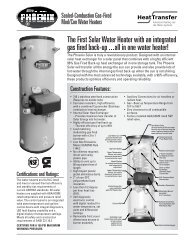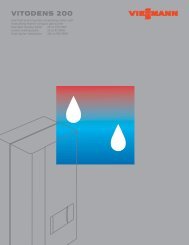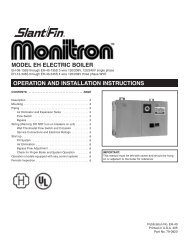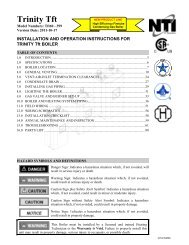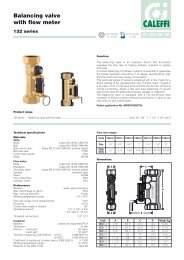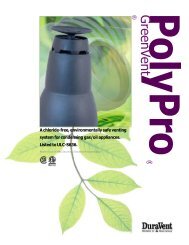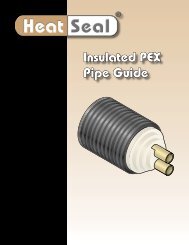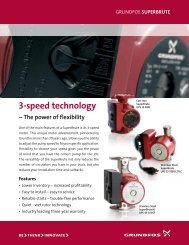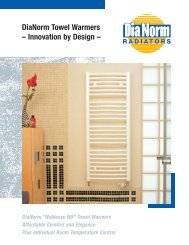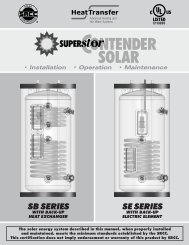Apricus Solar Water Heating System Installation and Operation ...
Apricus Solar Water Heating System Installation and Operation ...
Apricus Solar Water Heating System Installation and Operation ...
Create successful ePaper yourself
Turn your PDF publications into a flip-book with our unique Google optimized e-Paper software.
<strong>Apricus</strong> <strong>Solar</strong> Collector <strong>Installation</strong> & <strong>Operation</strong> Manual - USAIt is common to have multiple solar storage tanks connected in parallel all feeding a final boosting (orindirect) tank(s) heated by a boiler. By having a final boosted tank, a buffer of hot water is maintained, whichbetter allows the system to meet variations in hot water dem<strong>and</strong> <strong>and</strong> peak dem<strong>and</strong>. For example, peak hotwater requirements may on occasion exceed the output of the boiler, but by having a “buffer” tank, thatdem<strong>and</strong> can be met.It is also possible to prioritize heating, when tanks are connected in series. The last solar storage tankbefore the electrically or gas boosted tank is heated first, then once up to temperature, the next solarstorage tank is heated with solar. This allows the hottest water to be delivered to the system auxiliary waterheater (tankless water heater, final boosted tank, etc.) at all times, rather than having multiple tanks of justwarm water, while still allowing for a great deal of total solar storage capacity, as well as the ability to meethigh peak dem<strong>and</strong>.3.4. Pipe Type & Size3.4.1. Pipe Materiala) The solar collector loop can get very hot <strong>and</strong>, therefore, the only recommended material choices arecopper (hard or soft coiled) or corrugated flexible stainless steel pipe.b)Plastic or rubber piping material are ONLY suitable if they meet the following requirements:3.4.2. Pipe Sizei) Able to withst<strong>and</strong> sustained temperatures of 392°F (200°C)ii) Will not degrade when used in contact with the heat transfer fluid, including fluid in a semi-degradedstate due to repeated stagnation.iii) Able to withst<strong>and</strong> twice (2x) the st<strong>and</strong>ard pressure setting of the system throughout the fulloperating temperature range.iv) Able to withst<strong>and</strong> the lowest ambient temperatures likely to be encountered -58°F (-50°C) in someregions).At present, <strong>Apricus</strong> is not aware of any materials that both meet this criteria <strong>and</strong> have been extensivelyfield tested.a) Pipe Selection: When selecting the size of the pipe for the solar loop or any plumbing, there are twomain concerns: flow rate <strong>and</strong> pressure dropThese two factors are closely related; a higher pressure drop will reduce the flow rate. Pressure drop isincreased with a smaller diameter pipe, as well as the presence of bends, elbows <strong>and</strong> other componentsthat will restrict the flow of the water such as corrugated stainless steel piping. A relatively direct,unobstructed flow path is highly desirable.b) Pipe Diameter: See table below for basic pipe sizing:Number of TubesPipe Size10-20 1/2”30-90 3/4”90-240 1”It is advised that even if installing under 30 tubes 3/4” pipe be used as more collectors may be added in thefuture.c) Pump Size: The selection of the pipe size is linked to selection of the pump size <strong>and</strong> both are dependentupon the desired flow rate, which in turn is dictated by the number of collectors <strong>and</strong> ultimately, the designload. A more powerful pump will be able to achieve the desired flow rate through a pipe with higher pressuredrop (meaning a smaller diameter, longer or less direct run, etc). A balance needs to be met between thesize of the piping (bigger costs most) <strong>and</strong> the wattage of the pump (electricity costs). Also, larger piping willgenerally dissipate more heat than small piping due to a larger surface area.d) Sizing Tools: There are simple tools available from pump companies, such as Bell & Gossett <strong>and</strong>Copyright 2011 – <strong>Apricus</strong> Inc Doc: A7-05.4.1.4-PB-1.9 Page 18 of 126



